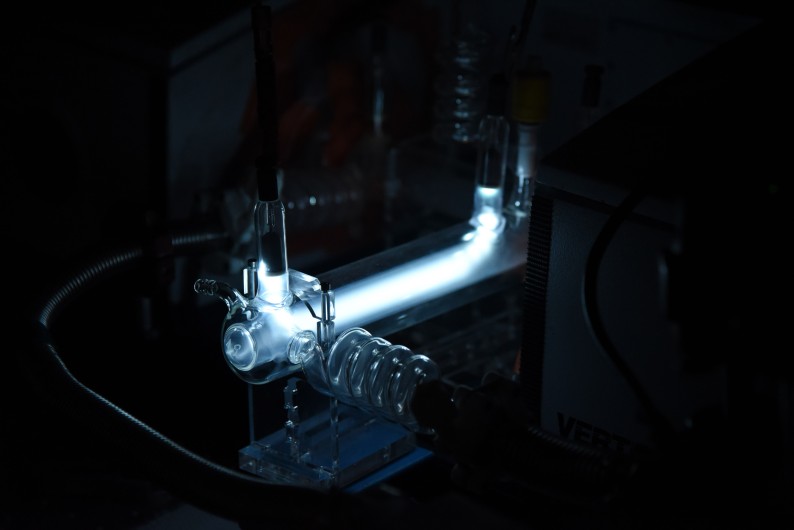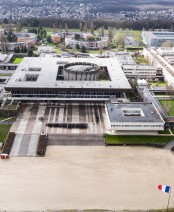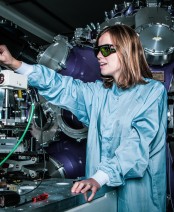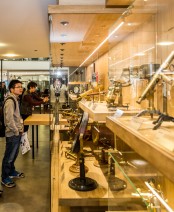Plasma-assisted methanation for CO2 recycling

The energy transition is a major challenge in the fight against global warming. Recycling part of the carbon dioxide (CO2) emitted by human activities is one of the solutions, along with the development of renewable energies, energy efficiency, sobriety and CO2 storage. This ecological issue motivated Edmond Baratte to embark on a thesis at the Plasma Physics Laboratory (LPP*): "I wanted to learn more about CO2 and the means of recycling it, not only the fundamental scientific aspects, but also those that could lead to a product with added value."
Following on from his thesis work, the Technology Transfer Accelerator Office of Paris-Saclay (SATT Paris-Saclay) has just granted him funding of €115,000 over 14 months to improve a prototype for the conversion of a mixture of CO2 and dihydrogen (H2) into methane (CH4). The latter is the molecule found in natural gas, which is widely used for heating, for example. This methanation process - which differs from methanisation or anaerobic digestion, which forms methane from the decomposition of waste - reduces the use of fossil resources provided that the H2 is also produced with a low carbon footprint, for example by water electrolysis.
Targeted energy deposit
At present, methanation is hardly implemented on an industrial scale. A few demonstrations have been carried out. "The main method consists in heating and compressing a CO2 and H2 mixture, but this requires a lot of energy," stresses Edmond Baratte. The plasma approach involves depositing targeted energy on the molecules to trigger the reaction, without wasting too much energy in the form of heat.
Plasmas refer to a state of matter in which electrons are stripped from the atoms with which they are usually associated. When the temperature of the gas remains low, as is the case here, they are called 'cold' plasmas. The LPP is an expert in this field, especially Olivier Guaitella, Edmond Baratte's thesis supervisor, who has been studying CO2 plasmas for several years. In his group at LPP, the plasma is created by applying an electric field which accelerates the electrons. The electrons collide many times with the CO2 molecules, which store this energy, notably in the form of vibrations. This extra energy makes the CO2 more reactive and therefore easier to dissociate.
During his thesis, Edmond Baratte studied the fundamental mechanisms of CO2 and CH4 joint plasma recycling. "These plasmas are interesting but also difficult to analyse because several chemical reaction paths can occur, sometimes in parallel. After the first experiments, we hoped to be able to understand directly what was going on in the plasma, but it turned out to be more complicated," explains the young researcher. In collaboration with IST Lisbon, he has developed and validated a numerical model that makes it possible to predict the reaction paths, i.e. how the molecules dissociate and reassemble.
Testing efficiency on an industrial scale
In the SATT-funded "Cycles" project, the starting point is no longer a mixture of CO2 and CH4, but a mixture of CO2 and H2. However, the chemistry remains the same and his thesis work will help to understand this new case. "With the soaring price of natural gas since the war in Ukraine, it is no longer economically relevant to use methane as an input," says Edmond Baratte. The aim will be to demonstrate the effectiveness of methanation by radiofrequency discharge plasma, with quantities of CO2 treated of the order of one cubic metre per day, compatible with industrial scale. The aim is also to test conditions similar to those at the exit of a factory chimney, where the gas mixture is never pure, but also contains nitrogen, for example.
Thanks to a pre-maturation project at Institut Polytechnique de Paris during his thesis, Edmond Baratte has already been able to lay the first foundations for a prototype plasma reactor. Among the challenges that still need to be overcome is the identification of the best metal catalysts possible in order to reduce the energy required to trigger methanation. The work carried out by another LPP doctoral student, Carolina Garcia Soto, on the interactions between plasmas and surfaces will be very useful. “I will also test an innovative source, which will create plasmas with different properties. There is therefore a purely scientific interest in the project beyond the industrial application," adds the physicist, who will be able to work on this subject for at least one more year at the LPP, where he enjoys the atmosphere. If the project is successful, he plans to found a start-up or to carry out a technology transfer to a possible industrial partner.
*LPP: a joint research unit CNRS, Observatoire de Paris-PSL, Sorbonne Université, Université Paris-Saclay, École Polytechnique, Institut Polytechnique de Paris, 91120 Palaiseau, France








